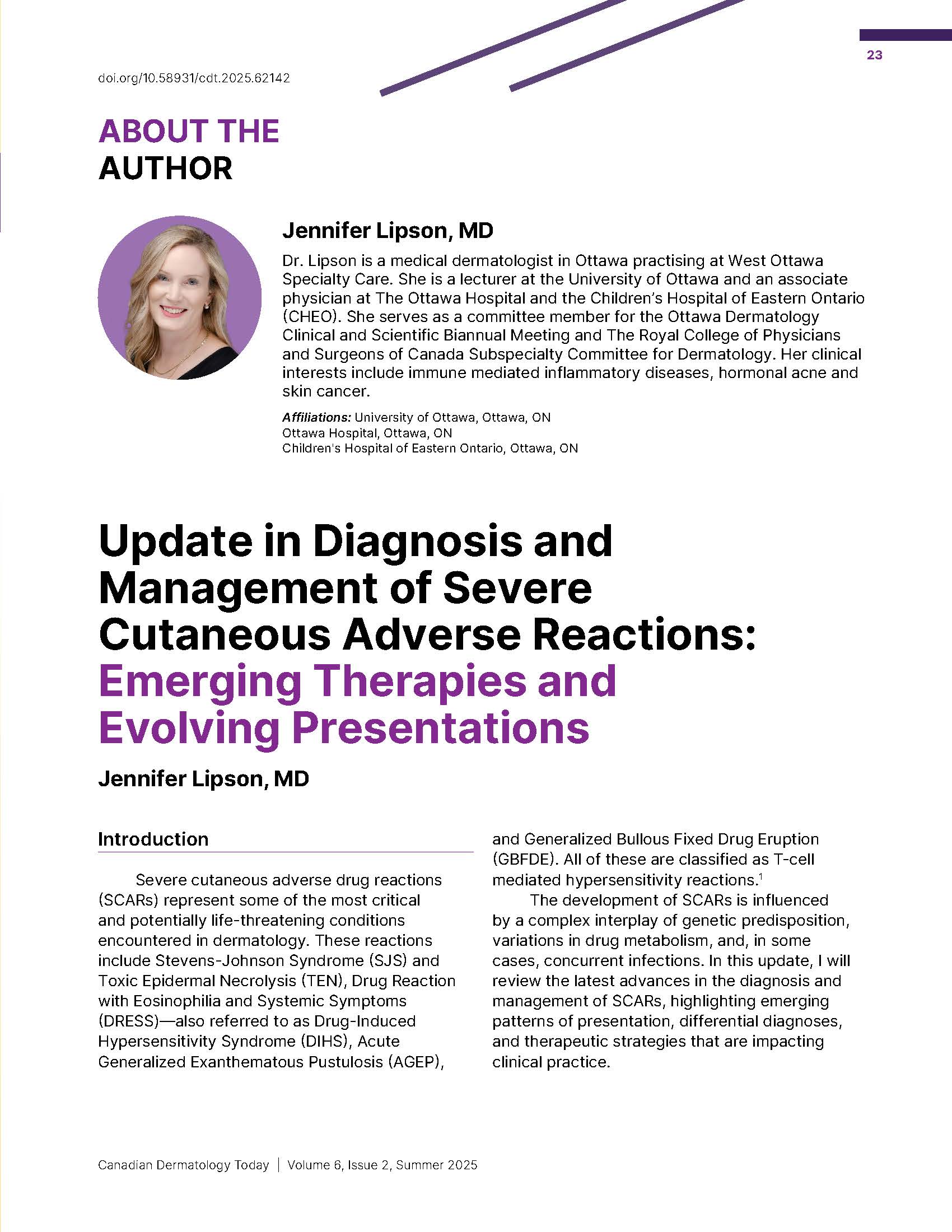Update in Diagnosis and Management of Severe Cutaneous Adverse Reactions: Emerging Therapies and Evolving Presentations
DOI:
https://doi.org/10.58931/cdt.2025.62142Abstract
Severe cutaneous adverse drug reactions (SCARs) represent some of the most critical and potentially life-threatening conditions encountered in dermatology. These reactions include Stevens‑Johnson Syndrome (SJS) and Toxic Epidermal Necrolysis (TEN), Drug Reaction with Eosinophilia and Systemic Symptoms (DRESS)—also referred to as Drug-Induced Hypersensitivity Syndrome (DIHS), Acute Generalized Exanthematous Pustulosis (AGEP), and Generalized Bullous Fixed Drug Eruption (GBFDE). All of these are classified as T-cell mediated hypersensitivity reactions.
The development of SCARs is influenced by a complex interplay of genetic predisposition, variations in drug metabolism, and, in some cases, concurrent infections. In this update, I will review the latest advances in the diagnosis and management of SCARs, highlighting emerging patterns of presentation, differential diagnoses, and therapeutic strategies that are impacting clinical practice.
References
Gibson A, Deshpande P, Campbell CN, Krantz MS, Mukherjee E, Mockenhaupt M, et al. Updates on the immunopathology and genomics of severe cutaneous adverse drug reactions. J Allergy Clin Immunol. 2023;151(2):289-300.e284. doi:10.1016/j.jaci.2022.12.005
Hung SI, Mockenhaupt M, Blumenthal KG, Abe R, Ueta M, Ingen-Housz-Oro S, et al. Severe cutaneous adverse reactions. Nat Rev Dis Primers. 2024;10(1):30. doi:10.1038/s41572-024-00514-0
Ubukata N, Nakatani E, Hashizume H, Sasaki H, Miyachi Y. Risk factors and drugs that trigger the onset of Stevens-Johnson syndrome and toxic epidermal necrolysis: a population-based cohort study using the Shizuoka Kokuho database. JAAD Int. 2023;11:24-32. doi:10.1016/j.jdin.2022.12.002
Nordmann TM, Anderton H, Hasegawa A, Schweizer L, Zhang P, Stadler PC, et al. Spatial proteomics identifies JAKi as treatment for a lethal skin disease. Nature. 2024;635(8040):1001-1009. doi:10.1038/s41586-024-08061-0
Zimmermann S, Sekula P, Venhoff M, Motschall E, Knaus J, Schumacher M, et al. Systemic immunomodulating therapies for Stevens-Johnson syndrome and toxic epidermal necrolysis: a systematic review and meta-analysis. JAMA Dermatol. 2017;153(6):514-522. doi:10.1001/jamadermatol.2016.5668
Wang CW, Yang LY, Chen CB, Ho HC, Hung SI, Yang CH, et al. Randomized, controlled trial of TNF-α antagonist in CTL-mediated severe cutaneous adverse reactions. J Clin Invest. 2018;128(3):985-996. doi:10.1172/jci93349
Tsai TY, Huang IH, Chao YC, Li H, Hsieh TS, Wang HH, et al. Treating toxic epidermal necrolysis with systemic immunomodulating therapies: a systematic review and network meta-analysis. J Am Acad Dermatol. 2021;84(2):390-397. doi:10.1016/j.jaad.2020.08.122
Ao S, Gao X, Zhan J, Ai L, Li M, Su H, et al. Inhibition of tumor necrosis factor improves conventional steroid therapy for Stevens-Johnson syndrome/toxic epidermal necrolysis in a cohort of patients. J Am Acad Dermatol. 2022;86(6):1236-1245. doi:10.1016/j.jaad.2022.01.039
Jacobsen A, Olabi B, Langley A, Beecker J, Mutter E, Shelley A, et al. Systemic interventions for treatment of Stevens-Johnson syndrome (SJS), toxic epidermal necrolysis (TEN), and SJS/TEN overlap syndrome. Cochrane Database Syst Rev. 2022;3(3):Cd013130. doi:10.1002/14651858.CD013130.pub2
Tonkin R, Ladha M, Johnson N, Astle WF, Britton A, Shear NH, et al. Reactive infectious mucocutaneous eruption - repeat etanercept after intravenous immunoglobulin: a case report. SAGE Open Med Case Rep. 2022;10:2050313x221117887. doi:10.1177/2050313x221117887
Wasuwanich P, Egerman RS, Wen TS, Motaparthi K. A nationwide study of Stevens-Johnson syndrome and toxic epidermal necrolysis in hospitalized pregnant women in the United States, 2009-2020. JAAD Int. 2024;16:175-182. doi:10.1016/j.jdin.2024.04.002
Quach HT, Johnson DB, LeBoeuf NR, Zwerner JP, Dewan AK. Cutaneous adverse events caused by immune checkpoint inhibitors. J Am Acad Dermatol. 2021;85(4):956-966. doi:10.1016/j.jaad.2020.09.054
Chen A, Kolodney JA, Kolodney MS. Retrospective cohort study characterizing PD-1/PD-L1 checkpoint inhibition associated Stevens-Johnson syndrome and toxic epidermal necrolysis. J Am Acad Dermatol. 2024;91(5):948-949. doi:10.1016/j.jaad.2024.06.066
Molina GE, Yu Z, Foreman RK, Reynolds KL, Chen ST. Generalized bullous mucocutaneous eruption mimicking Stevens-Johnson syndrome in the setting of immune checkpoint inhibition: a multicenter case series. J Am Acad Dermatol. 2020;83(5):1475-1477. doi:10.1016/j.jaad.2020.03.029
Driscoll W, Yale K, Smith J. A case of pembrolizumab-induced toxic epidermal necrolysis with a delayed developmental timeline. JAAD Case Rep. 2024;53:27-29. doi:10.1016/j.jdcr.2024.08.011
Hama N, Abe R, Gibson A, Phillips EJ. Drug-induced hypersensitivity syndrome (DIHS)/drug reaction with eosinophilia and systemic symptoms (DRESS): clinical features and pathogenesis. J Allergy Clin Immunol Pract. 2022;10(5):1155-1167.e1155. doi:10.1016/j.jaip.2022.02.004
Wei BM, Fox LP, Kaffenberger BH, Korman AM, Micheletti RG, Mostaghimi A, et al. Drug-induced hypersensitivity syndrome/drug reaction with eosinophilia and systemic symptoms. Part I. Epidemiology, pathogenesis, clinicopathological features, and prognosis. J Am Acad Dermatol. 2024;90(5):885-908. doi:10.1016/j.jaad.2023.02.072
Kim D, Kobayashi T, Voisin B, Jo JH, Sakamoto K, Jin SP, et al. Targeted therapy guided by single-cell transcriptomic analysis in drug-induced hypersensitivity syndrome: a case report. Nat Med. 2020;26(2):236-243. doi:10.1038/s41591-019-0733-7
Blumenthal KG, Alvarez-Arango S, Kroshinsky D, Lo YC, Samarakoon U, Salem AR, et al. Drug reaction eosinophilia and systemic symptoms: clinical phenotypic patterns according to causative drug. J Am Acad Dermatol. 2024;90(6):1240-1242. doi:10.1016/j.jaad.2023.05.067
Parisi R, Shah H, Navarini AA, Muehleisen B, Ziv M, Shear NH, et al. Acute generalized exanthematous pustulosis: clinical features, differential diagnosis, and management. Am J Clin Dermatol. 2023;24(4):557-575. doi:10.1007/s40257-023-00779-3
Russo G, Dumont S, Menzinger S, Pastor D, Toutous Trellu L, Kaya G, et al. Severe acute generalized exanthematous pustulosis successfully treated by spesolimab. Acta Derm Venereol. 2024;104:adv41311. doi:10.2340/actadv.v104.41311
Xuan Y, Jin S, Zhang C, Wang S. Rapid improvement in refractory acute generalized exanthematous pustulosis with spesolimab. JAMA Dermatol. 2024;160(9):1009-1012. doi:10.1001/jamadermatol.2024.2311
Paulmann M, Reinkemeier F, Lehnhardt M, Mockenhaupt M. Case report: generalized bullous fixed drug eruption mimicking epidermal necrolysis. Front Med (Lausanne). 2023;10:1125754. doi:10.3389/fmed.2023.1125754


